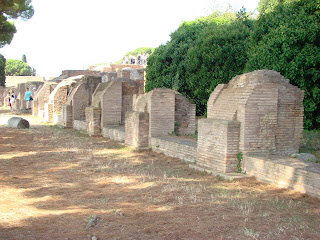Lido di Ostia is the closest beach to the city of Rome and is well worth a visit.
Stop off at the ruins at Ostia Antica a large archeological site that was the harbour city of ancient Rome, which is approximately 30 kilometres (19 mi) northeast of the site and close to the modern town of Ostia. "Ostia" in Latin means "mouth". At the mouth of the River Tiber, Ostia was Rome's seaport, but, due to silting and a drop in sea level, the site now lies 3 kilometres (2 mi) from the sea. The site is noted for the excellent preservation of its ancient buildings, magnificent frescoes and impressive mosaics.
Ostia may have been Rome's first colonia. An inscription says that Ostia was founded by Ancus Marcius, the semi-legendary fourth king of Rome, in the 7th century BC. The oldest archaeological remains so far discovered date only the 4th century BC." The most ancient buildings currently visible are from the 3rd century BC, notably the Castrum (military camp); of a slightly later date is the Capitolium (temple of Jupiter, Juno and Minerva). The opus quadratum of the walls of the original castrum at Ostia provide important evidence for the building techniques that were employed in Roman urbanisation during the period of the Middle Republic.
In 68 BC, the town was sacked by pirates. During the sacking, the port was set on fire, the consular war fleet was destroyed, and two prominent senators were kidnapped. This attack caused such panic in Rome that Pompey Magnus arranged for the tribune Aulus Gabinius to rise in the Roman Forum and propose a law, the Lex Gabinia, to allow Pompey to raise an army and destroy the pirates. Within a year, the pirates had been defeated.
The town was then re-built, and provided with protective walls by the statesman and orator Marcus Tullius Cicero.
The town was further developed during the first century AD under the influence of Tiberius, who ordered the building of the town's first Forum. The town was also soon enriched by the construction of a new harbor on the northern mouths of the Tiber (which reaches the sea with a larger mouth in Ostia, Fiumara Grande, and a narrower one near to the current Fiumicino International Airport). The new harbor, not surprisingly called Portus, from the Latin for "harbor," was excavated from the ground at the orders of the emperor Claudius. This harbour became silted up and needed to be supplemented later by a harbor built by Trajan finished in the year AD 113; it has a hexagonal form, in order to reduce the erosive forces of the waves. This took business away from Ostia itself (further down river) and began its commercial decline.
Ostia itself was provided with all the services a town of the time could require; in particular, a famous lighthouse. Ostia contained the Ostia Synagogue, the earliest synagogue yet identified in Europe; it created a stir when it was unearthed in 1960-61.[4] By 1954 eighteen mithraea had also been discovered: Mithras had his largest following among the working population that were the majority of this port town. Archaeologists also discovered the public latrinas, organized for collective use as a series of seats that allow us to imagine today that the function was also a social moment. In addition, Ostia had a large theatre, many public baths, numerous taverns and inns, and a firefighting service.
Trajan too, required a widening of the naval areas, and ordered the building of another harbor, again pointing towards the north. It must be remembered that at a relatively short distance, there was also the harbor of Civitavecchia (Centum Cellae), and Rome was starting to have a significant number of harbours, the most important remained Portus.
Santa Aurea, OstiaOstia grew to 50,000 inhabitants in the 2nd century, reaching a peak of some 75,000 inhabitants in the 2nd and 3rd centuries AD.[citation needed] Ostia became an episcopal see as early as the 3rd century, the cathedral (titulus) of Santa Aurea (illustration, left) being located on the burial site of St. Monica, mother of Augustine; she died in an inn in the town. In time, naval activities became focused on Portus instead. A slow decadence began in the late Roman era around the time of Constantine I, with the town ceasing to be an active port and instead becoming a popular country retreat for rich aristocrats from Rome itself (along the lines of Brighton's relationship to London in the 18th century).
The decaying conditions of the city were mentioned by St. Augustine when he passed there in the late 4th century. The poet Rutilius Namatianus also reported the lack of maintenance of the city in 414.
With the end of the Roman Empire, Ostia fell slowly into decay, and was finally abandoned in the 9th century due to the repeated invasions and sackings by Arab pirates, including the Battle of Ostia, a naval battle in 849 between Christian and Saracens; the remaining inhabitants moved to Gregoriopolis.








No comments:
Post a Comment